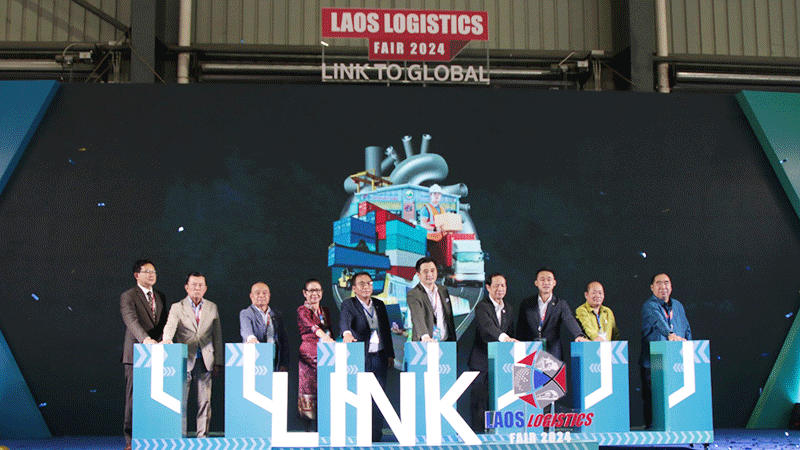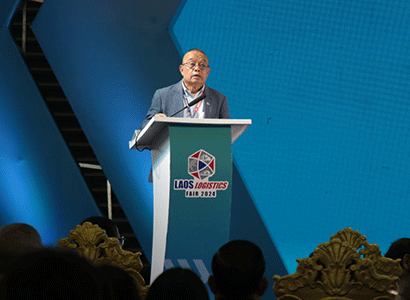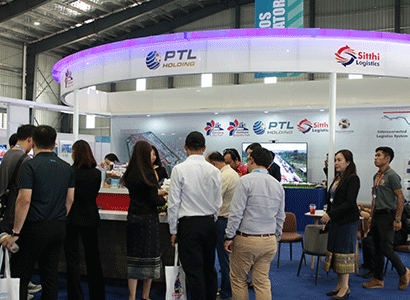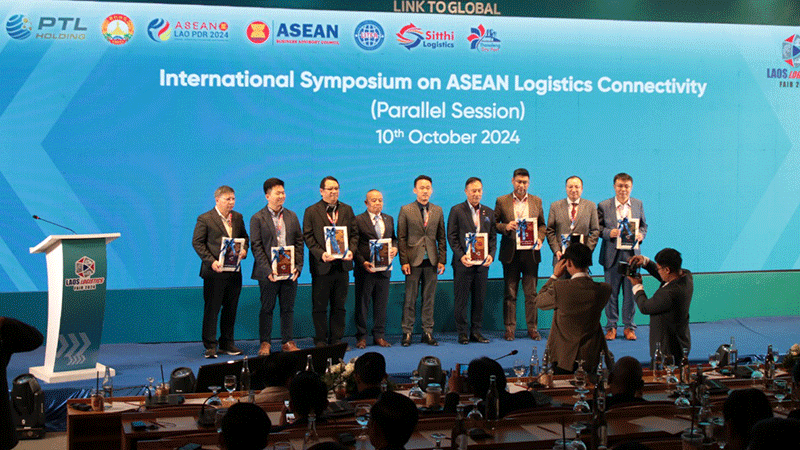 |
Senior government officials and executives of Thanaleng Dry Port press a button to open the first Laos Logistics Fair. |
Int’l symposium highlights ‘Railway Implications and Prospects’
An international symposium titled ASEAN Logistics Connectivity and the first Laos Logistics Fair held last week in Vientiane highlighted the ‘implications and prospects’ delivered by the Laos-China railway for Laos and the rest of the region.
Presentations centred on how the rail trade route, an important gateway between China and Southeast Asia, has improved market accessibility and impacted the trading environment.
While the Laos-China railway, which opened for service in December 2021, has transformed landlocked Laos to a land link, one expert in the field suggested that more interconnection is needed to improve accessibility and maximise the benefits offered.
Director of the Centre of Excellence in Connectivity at Thailand’s Thammasat University, Professor Dr Ruth Banomyong, said the railway needs to connect to other forms of transport to form a seamless connection and create ‘an enabling environment’.
 |
 |
| Mr Sakhone Philangam delivers his speech at the first Laos Logistics Fair. |
The audience at the first Laos Logistics Fair. |
Addressing a session titled ‘Laos-China Railway – a Game Changer’, Dr Ruth said connectivity is critically important to link Laos with the rest of the region to boost and diversify investment and bolster trade.
He noted that the time-saving and reliability guaranteed by rail transport appeared to be the key attractive factors.
Geographical location is often taken into account when it comes to rail transport, with inland cities being more advantaged. But cheaper maritime routes are more competitive for coastal areas, Dr Ruth said.
“We do see that if it’s a coastal region of China, there’s no advantage. But if you go on the western side of China, there is an advantage,” he told the symposium, a sideline event of the ASEAN Summits hosted by Laos.
His insight was part of findings of the research the professor jointly conducted with colleagues from the World Bank last year. Research included accounts from interviewing local logistics providers in Laos and data collected from about 400 exporters and importers.
Dr Ruth added that speed has made rail transport a good option, saying that the average shipment lead time has dropped by 22 percent.
“As we say, time is money, so there’s a value attached to that time saving,” he said.
In addition, rail transport is considered to be more reliable and safer than road transport. Statistics show that damaged shipments are down by 23 percent.
“When you look at it from a logistics, supply chain perspective, it is critical to be able to have reliable logistics. It also offers a new channel to access the Chinese market,” the professor said.
 |
Dr Ruth Banomyong (third from left), Mr Sakhone Philangam (fourth from left), other speakers and guests gather for a group photo at the International Symposium on ASEAN Logistics Connectivity. |
Thanks to its advantages, the Laos-China railway has recorded a significant increase in cargo volume.
In 2023, the Lao section of the railway alone registered freight transport rising to 4.089 million tonnes, a year-on-year increase of 83.1 percent.
As part of the pan-Asia rail network to link China’s Kunming to Singapore via Laos, Thailand and Malaysia, the Laos-China railway has increasingly become an important trade gateway between ASEAN and China.
While waiting for the standard-gauge Laos-China railway to link with Thailand, Malaysia and Singapore’s networks, the region is currently connecting through existing infrastructure.
The one-metre-gauge Thailand and Malaysia’s rail network converges with the standard-gauge Laos-China railway at the Thanaleng Dry Port, Laos’ integrated logistics centre in Vientiane, which enables a seamless connection linking Southeast Asia all the way to Europe by rail.
Dr Ruth said it is important to have this interface facility for cargo transloading.
Thanaleng Dry Port’s Managing Director Sakhone Philangam told the symposium that his multimodal transport mode ‘the dry port’ has been positioned as a key transport and logistics hub within the Greater Mekong Sub-region, leveraging its strength of being well connected through overland high-capacity transport means and corridors.
Recognised as an international trade and transport location, the dry port functions mainly to facilitate trade and transport between Laos, Thailand, China, Vietnam and beyond.
Also addressing the symposium, Deputy Minister of Public Works and Transport Mr Litta Khattiya said Laos’ strategic location surrounded by China, Thailand, Vietnam, Cambodia and Myanmar offers an advantage to facilitate the flow of goods across ASEAN, contributing to regional trade and economic growth.
“Laos is playing a central role in reducing trade barriers, lowering transport costs, and speeding up the delivery of goods across borders,” he said.
“We aim to develop a fully integrated logistics system that will facilitate seamless transport, helping ASEAN realise its goal of becoming a single market and production base.”
To forge closer links and foster partnership among entrepreneurs in the region, the first Laos Logistics Fair was held a day after the symposium.
Taking place at the Thanaleng Dry Port, the fair, which was jointly organised by the Lao International Truckers and Forwarders Association and the dry port management, showcased booths and logistics service products, offering opportunities.
The symposium and the fair took place at a timely moment given their relevance to Laos’ ASEAN chairmanship theme of “ASEAN: Enhancing Connectivity and Resilience”.
By Advertorial Desk
(Latest Update October 17, 2024)
|





